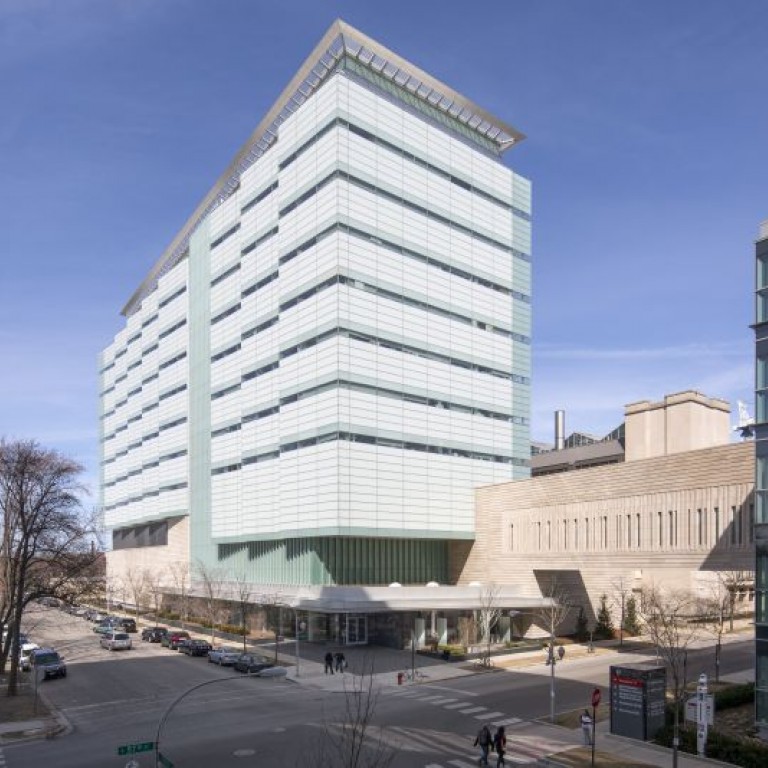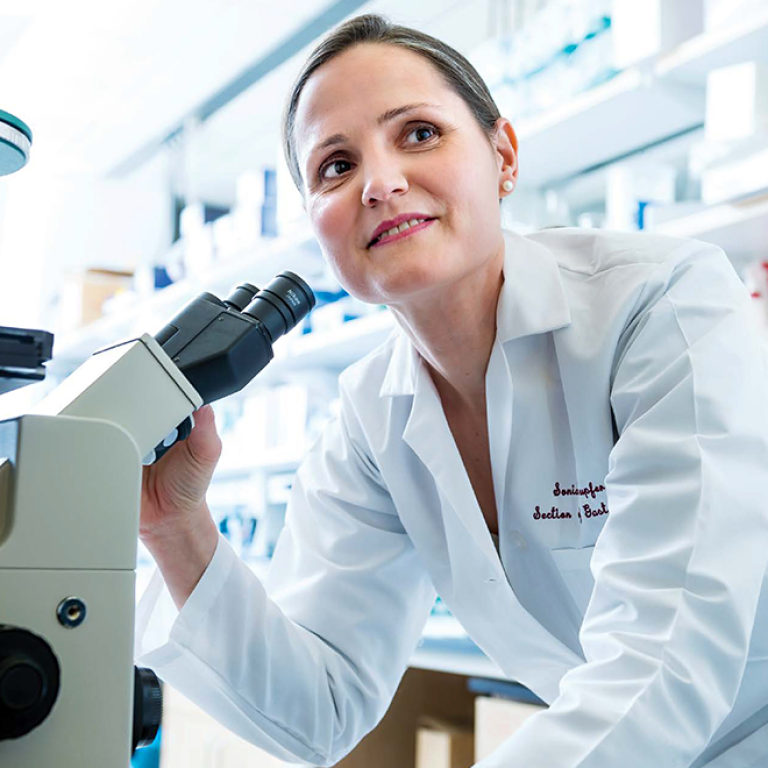Lung tumors shrinking.
Melanomas melting away.
Metastatic kidney tumors disappearing for good.
When the Food and Drug Administration approved the first immunotherapy for cancer in 2011, it ushered in a new era for care. Patients had a reason for hope: The cancers that had previously evaded immune cells could be targeted and destroyed by their body’s own defense system, similar to how it might fight off a cold.
Since then, the number and types of immunotherapies have increased, putting many patients in remission, or even curing them. But physicians and scientists continue to face a stubborn reality: Immunotherapies work best for certain kinds of cancers, and the treatments are effective for only about 20% of patients.
This story appeared in Medicine on the Midway magazine. Read the Spring 2025 issue here.
“The immunotherapy field had this meteoric rise, and then it stalled a bit as we tried to figure out why it didn’t work for everyone,” said Thomas Gajewski, MD, PhD, the AbbVie Foundation Professor of Cancer Immunotherapy in the Departments of Pathology and Medicine at the University of Chicago. “But it is starting to tick up again as resistance mechanisms are being uncovered.
“We are going to get to a point where immunotherapy works in a majority of patients.”
It’s the kind of challenge that motivates Gajewski and UChicago researchers — one that involves painstaking analysis of biological systems, state- of-the-art technologies and collaboration across disciplines.
As they work at the forefront of creating new immunotherapies, expert teams also hope to gain a clearer understanding of why current approaches do not cure everyone.
From ‘religion’ to reality
Cancer can evade the immune system in several ways. Some types are naturally less visible, while others have proteins on their surface that turn off immune cells. Other cancers interfere with the environment around a tumor, hindering the immune system’s ability to attack it.
Studies as far back as the 1890s have explored the potential of harnessing the immune system to fight cancer. But for decades, as clear answers or options remained elusive, the standard of care focused on surgery, radiation and chemotherapy.
Gajewski, an immunologist and medical oncologist, has long theorized that the immune system is relevant to every area of medicine. Looking for the hardest problem to study, he turned to cancer in the early 1990s — a time when “nobody was doing cancer immunotherapy” and “the field was more on a religion level.”
He studied with Belgian scientist Thierry Boon, a distinguished immunology researcher who had discovered the first tumor-associated antigen that would enable the immune system’s T cells to recognize cancer cells.
That informed Gajewski’s early work in understanding immune checkpoint therapy involving the CTLA-4 protein’s role in serving as the “brakes” for a key biological process.
When this protein, found on T cells, binds to another protein known as B7, it prevents the T cell from killing healthy cells. Unfortunately, it can also prevent these mighty T cells from attacking cancer.
But if this checkpoint protein was blocked, scientists found, the immune system could attack and potentially eliminate tumors. This discovery led to the FDA’s approval of the first checkpoint inhibitor immunotherapy in 2011.
Another checkpoint inhibitor therapy — which blocks the PD-L1 proteins on tumors that turn down T-cell responses through the inhibitory receptor PD-1 — followed a few years later. The discovery led to a Nobel Prize for two scientists in 2018.
Since then, millions have received these drugs, with triumphant stories abounding in melanoma and lung cancer cases, where the approach can be effective for 30% to 60% of patients.
“That has been the biggest success, and it is now approved for 20 different cancers,” said Gajewski, who also co-leads the Cancer and Immunology Program in the National Cancer Institute-designated University of Chicago Medicine Comprehensive Cancer Center. “It’s come full circle. At first, no one in the field believed us.
“Now, immunotherapy has become first-line therapy for many patients.”
‘Home run’ ambitions
Checkpoint inhibitors aren’t the only option. CAR T-cell therapy — a process in which a patient’s T cells are extracted and supercharged with a gene called a chimeric antigen receptor (CAR) — helps the immune system recognize and fight blood cancers like leukemia and lymphoma once the re-engineered T cells are put back into the body.
UChicago Medicine became the first site in Illinois to offer CAR T-cell therapy in 2017. In January, it was one of nine locations for a clinical trial studying the therapy’s effect on three autoimmune diseases: systemic lupus erythematosus, inflammatory myositis and systemic sclerosis.
CAR T-cell therapy, said Satyajit Kosuri, MD, a cellular therapy physician and Assistant Professor of Medicine, “is a broad platform that we can adapt and apply to certain patient populations with diseases that have been resistant to historically standard therapies. It may offer a new solution where previously there was none.”
Last year, another kind of cellular therapy called tumor-infiltrating lymphocyte (TIL) therapy was approved by the FDA as a treatment for advanced melanoma. UChicago Medicine was among the first places in the nation to offer it.
The therapy involves growing and activating a patient’s own TIL cells, which are specialized T cells that have moved from the bloodstream into a tumor. The body’s own small population of these cells cannot destroy a tumor, but if the cells are removed from the patient, multiplied into the billions and re-injected — the same strategy as CAR T-cell therapy — it creates a superpowered immune system to clear out the cancer.
“Cell immunotherapies have given us a lot of excitement,” said Daniel Olson, MD, an oncologist and Assistant Professor of Medicine who led the TIL therapy rollout at UChicago Medicine. One of Olson’s patients, the first in the Midwest to receive the new therapy, was able to vacation in Europe after 15 years of battling skin cancer.
Although only one-third to one-half of all recipients will see a benefit, “TIL has been able to cure patients who haven’t had success with other treatments,” Olson said, noting that the therapy requires advanced coordination among oncologists, surgeons and the cell therapy team.
The potential has UChicago Medicine oncologists and scientists at the David and Etta Jonas Center for Cellular Therapy studying the wider use of TIL therapy for other tumor types, including cervical, lung and colon cancers.
“We’re aiming for a home run,” Olson said. “We’re looking for transformative therapies that can really alter a patient’s immune system to fight cancer on its own, and do it for the long term. That’s what motivates us day to day.”
The role of radiation
As scientists continue to uncover and refine immunotherapies that work as a first-line offense, they’re also testing how to best combine them with widely used cancer treatments such as radiation — which, despite its cancer-killing powers, can also suppress immune cells.
Ralph Weichselbaum, MD, the Daniel K. Ludwig Distinguished Service Professor of Radiation and Cellular Oncology at UChicago, has studied this phenomenon, as well as ways to combine therapies. In a study published in the Journal of Clinical Investigation, Weichselbaum and his team found that the checkpoint PD-L1 protein, which turns down T-cell responses, was actually induced by radiation.
Put another way, if that protein is blocked by a checkpoint inhibitor, “you can actually improve the effects of radiation therapy,” Weichselbaum said.
In another paper, published in 2023 in Cancer Cell, Weichselbaum and Chuan He, PhD, the John T. Wilson Distinguished Service Professor of Chemistry in the Physical Sciences Division and Professor of Biochemistry and Microbiology in the Biological Sciences Division, found that a reader of RNA methylation called YTHDF2 induces immune suppression. Blocking YTHDF2, they found, improved the positive effects of radiotherapy.
Weichselbaum is on the hunt to find more immunotherapy options that could enhance the positive effects of radiation. A decade ago, Weichselbaum, Gajewski and others found that mice that lacked a specific protein pathway called STING (stimulator of interferon genes) could not mount an immune response to cancer in conjunction with immunotherapy or high-dose radiation. They recently published a paper in Immunity outlining the findings.
Since then, STING has become a target to make “cold” tumors “hot” — in other words, to have more T cells and therefore be more responsive to immunotherapy and radiation.
Weichselbaum is currently collaborating with Wenbin Lin, PhD, the James Franck Professor of Chemistry, to develop nanoparticles that can activate the STING pathway.
“These combinations of treatments are either in clinical trials or will soon be,” Weichselbaum said. “It’s been very gratifying. It’s a real chance to help people.”
Immunotherapy-first approach
While the first immunotherapies were given to patients with metastatic cancers who had already run through other treatment options, physicians are now testing the opposite: trying immunotherapy first.
This neoadjuvant method, UChicago scientists have found, has improved outcomes with limited side effects for some patients.
Consider, for example, patients with head and neck cancers caused by human papillomavirus (HPV). They have high survival rates but often face side effects from chemotherapy and radiation that affect the ability to speak and swallow.
In a recent clinical trial, Ari Rosenberg, MD, Assistant Professor of Medicine, started treatment on patients with head and neck cancer by administering a checkpoint inhibitor immunotherapy along with an initial dose of chemotherapy, a strategy called chemoimmunotherapy. Patients then received a reduced dose of chemotherapy and radiation.
“The results were very promising,” said Rosenberg, whose findings were published last year in JAMA Oncology. “Patients had lower feeding tube rates and smaller changes in their weights during treatment. They also had improved swallowing outcomes.”
Next, the team decided to try the regimen with head and neck cancers not caused by HPV. Although these cancers are often caused by tobacco or alcohol use, physicians also are seeing a growing number of cases in nonsmokers. They recently published a study, also in JAMA Oncology, that showed excellent outcomes with fewer side effects for responding patients who received less radiation.
“Many of us are excited to be leveraging combinations of immunotherapy with other drugs and treatments to help improve outcomes for patients,” Rosenberg said.
Closing the gap
Ultimately, there is no single reason why immunotherapy might fail. Each patient is unique, and scientists must identify different strategies that consider their biological makeup.
Gajewski and many others have focused on the tumor microenvironment, the area around the tumor. Using advanced technologies like single-cell RNA sequencing and spatial transcriptomics — which shows how cells interact with each other to form a community — they have begun to understand the basic mechanisms behind immunotherapy successes.
For example, Gajewski and his team found that for T cells to fight cancer, they must be able to migrate into the tumor microenvironment. A major factor that attracts them is a chemokine called CXCL10.
In a follow-up study, published in the Journal for ImmunoTherapy of Cancer, Gajewski showed that expression of this chemokine was highly variable among patients, and those who had high expression had a better clinical response to checkpoint inhibitor immunotherapy.
Akash Patnaik, MD, PhD, MMSc, Deputy Section Chief for Translational Research in Hematology/ Oncology and program leader for the Clinical and Experimental Therapeutics Program at the Cancer Center, recently found that in patients with prostate cancer who don’t respond to immunotherapy, the immune system actually promotes the growth of cancer by recruiting tumor-associated macrophages that express PD-1 into the tumor microenvironment.
The findings were published in Clinical Cancer Research.
Macrophages — a type of white blood cell — are one key to improving immunotherapy. These cells can treat the cancer like an injury, preventing the immune system from attacking it while the body tries to repair it. But they can also be flipped to promote a strong immune response.
Gajewski and Patnaik are developing new drug strategies to do just that. “We want to flip the switch on the bad guys and make them the good guys, the anti-tumor guys that can then attack and kill cancer,” said Patnaik, who is also an Associate Professor of Medicine.
In 2017, Patnaik and a team showed that the drug cabozantinib reprogrammed immune cells called neutrophils — the first line of defense against bacterial infections. They’re now testing it in clinical trials with immunotherapies to see whether the combination improves outcomes in patients with prostate cancer.
For Patnaik, who lost an uncle to advanced prostate cancer, the quest to “crack the code” of immunotherapies is personal.
“We’re making progress each day,” he said. “It’s an exciting time, and there’s certainly a lot of promise with these approaches. As a physician-scientist, that’s the most rewarding aspect — to be able to do basic research that leads to clinical trials for patients and then take what we learn from those clinical trials back to the lab.”



